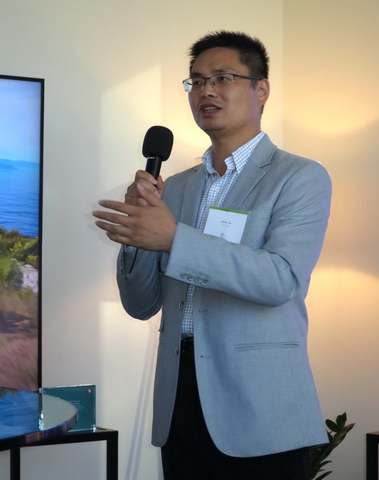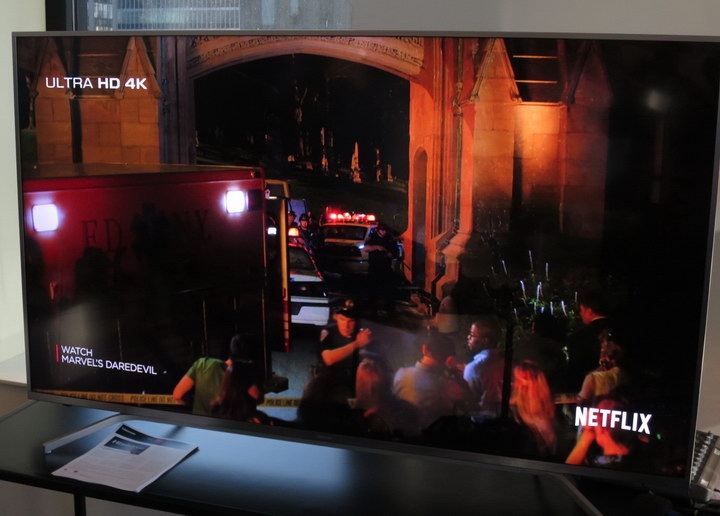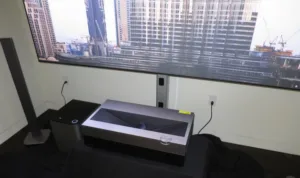Hisense showed a single 50” H8-series HDR TV at Pepcom, but showed the rest of its high-end, UHD HDR-compatible and HDR TV product line for the US at a dedicated press event on October 5th. At this event, they showed other members of the company’s H8 line, as well as the higher-end H9 product line and a prototype of a 70” H10 series HDR TV. They also showed their UHD short throw laser TV projector.
While Hisense has been the number 1 TV company in China for 13 years, Hisense USA is not widely known by consumers in the US and other countries. In order to change this, the company is aggressively expanding its footprint in the US and other countries around the world. Both the Hisense presence at Pepcom and this dedicated press event were part of this US footprint expansion.
 Hisense-USA CEO Jerry Liu explaining the company’s plans for the Americas (Photo: M. Brennesholtz)
Hisense-USA CEO Jerry Liu explaining the company’s plans for the Americas (Photo: M. Brennesholtz)
“At Hisense, we are dedicated to continually pushing the envelope with innovative design, technology and value to the consumer,” said Jerry Liu, CEO of Hisense Americas. “It only makes sense that as we continue to grow our presence in the United States, we bring our approach to affordable luxury to the larger screen television categories as well.”
The company is not just marketing Chinese-made TVs in the US. In 2016, the company purchased a factory in Mexico to better supply the Americas and expects its capacity to reach over 4 million units per year. The company also runs dedicated R&D centers in Atlanta, Georgia; San Jose, California; and Toronto, Canada to enable localized product development and innovation for the North American market.
Liu added, “At Hisense we are extremely proud of the picture technologies we put in every TV we make. We commit over five percent of our global revenues to research and development. This investment in research and development, efficient supply chain management and innovative manufacturing processes enable us to bring the best picture quality to consumers at more affordable prices.”
According to Mike Wong, Sr. Director of Product Management at Hisense USA, Hisense uses purchased LCD panels in all the company’s TVs. They make everything else, including the LED backlight systems, for the TVs.
Hisense commissioned Wakefield Research to do a blind study among 100 US consumers at a shopping mall, comparing the image quality of a Hisense set to Samsung and Visio sets. The 50” sets used were the Hisense 50H8 ($499 MSRP), a Samsung 50KU6300 ($630 at the on-line Samsung Store) and a Vizio E50UD2 ($520 MSRP, $500 at Costco). All three sets are similar 4K/UHD TVs. The study showed consumers found the image quality of the Hisense set was equal to the image quality of the Samsung set and significantly better than the image quality of the Vizio set.
The basic specifications for the televisions shown at the Hisense event are shown in the table. Note that the brightness (Nits or candela/m²) value is missing for many of these TVs. It was not on the data sheet distributed at the event and I only asked for the 86H8D set, where Wong said “about 300.” All of the sets had HDR10 processing on at least one HDMI input. That would put them in the “HDR Compatible” and not full HDR displays. The 70H10D, with 1000 cd/m² and 320 dimming zones should qualify as a full HDR10 TV. None of these sets support the Dolby Vision HDR system.
 Prototype of the Hisense 70” H10 HDR Smart Television (Photo: M. Brennesholtz)
Prototype of the Hisense 70” H10 HDR Smart Television (Photo: M. Brennesholtz)
| Series | H8 | H8 | H8 | H8 | H9 | H10 | Laser TV |
| Model | 65H8C | 70H8D | 75H8C | 86H8D | 65H9D | 70H10D | H9900 Series |
| Size | 65” | 70” | 75” | 86” | 65” | 70” | 100” |
| LEDs | WLED | WLED | WLED | WLED | ULED | ULED | Laser Phosphor |
| Zones (Local dimming) | No (Edge Lit) |
192 (Direct lit) |
Yes (Edge lit) |
Yes (Direct lit) |
Yes | 320 | NA |
| Nits | ? | ? | ? | About 300 | ? | 1000 | 2800 Lumens |
| Resolution | 4K/UHD | 4K/UHD | 4K/UHD | 4K/UHD | 4K/UHD | 4K/UHD | 4K/UHD pixel shift |
| Color | 83% DCI P3 | Rec. 709 | 83% DCI P3 | Rec. 709 | 83% DCI P3 | 90% Rec. 2020 | Rec. 709 |
| Static Contrast | 4000:1 | 4000:1 | 4000:1 | 4000:1 | ? | ? | ? |
| Dynamic Contrast | 1Million:1 | 1Million:1 | 1Million:1 | 1Million:1 | ? | 10Million:1 | NA |
| MSRP | $1000 | $2,500 | $2,500 | $6,000 | $1,700 | $3,500 | $12,999 |
| Available | Early 2017 | Dec. 2016 | Dec. 2016 | Early 2017 | Early 2017 | Early 2017 | Summer 2017 |
The 50” H8 set shown at Pepcom was said to be a full HDR set, with 1000 cd/m² of output. However, it only had 10 dimming zones, a very small number for an HDR set, where the number of zones typically is in the hundreds and can be over a thousand. While more zones provide better HDR images, they also add significant cost.
All of these sets have flat screens. The only member of the H10 series currently on the Hisense website, the 65” H10, has a R4000 curved screen but it was not shown at this event. That unit uses ULEDs, has a VA panel and has 240 dimming zones. Output is 875 cd/m² and the dynamic contrast is said to be 8,000,000:1. Colorimetry is said to be 140% of Rec.709 or 100% of NTSC. The unit is available now with a MSRP of $2800.
Hisense 100” Laser Phosphor Projector (Note: the image produced by this projector was much higher contrast than can be seen in this image because a flash was used to illuminate the projector unit. Photo: M. Brennesholtz)
A Hisense laser phosphor projector was shown at IFA last month but it isn’t clear that the one shown for the US market was identical or if it was modified for the US market. For example, the one shown in New York had Rec. 709 colorimetry specified but the one shown at IFA was said to have 116% of Rec. 709. The one shown at IFA was shown in a bright area with a contrast-enhancing screen while the one shown in New York was shown in a dim area on an ordinary diffuse reflection roll up screen. At IFA, it was not clear if the laser projector was Dolby Vision or only HDR10-compatible. The one in New York was specifically HDR10 only.
Analyst Comment
As can be expected, all of these sets, which ranged from $1000 to $12,999 looked good. While my background is projection, if I’d wanted a large screen TV, I would have preferred the 86” H8 to the laser projector on an image quality basis. The fact that the projector is more than twice as expensive as the direct view LCD while it only gives an extra 14” on the diagonal would be a big plus for the 86H8D, at least for me. While short throw DLP-based laser phosphor projectors for home theater use have been around for a number of years and I first wrote about LG’s version in April, 2013, this image quality and price differential may explain why the category has not yet taken off. –Matthew Brennesholtz

